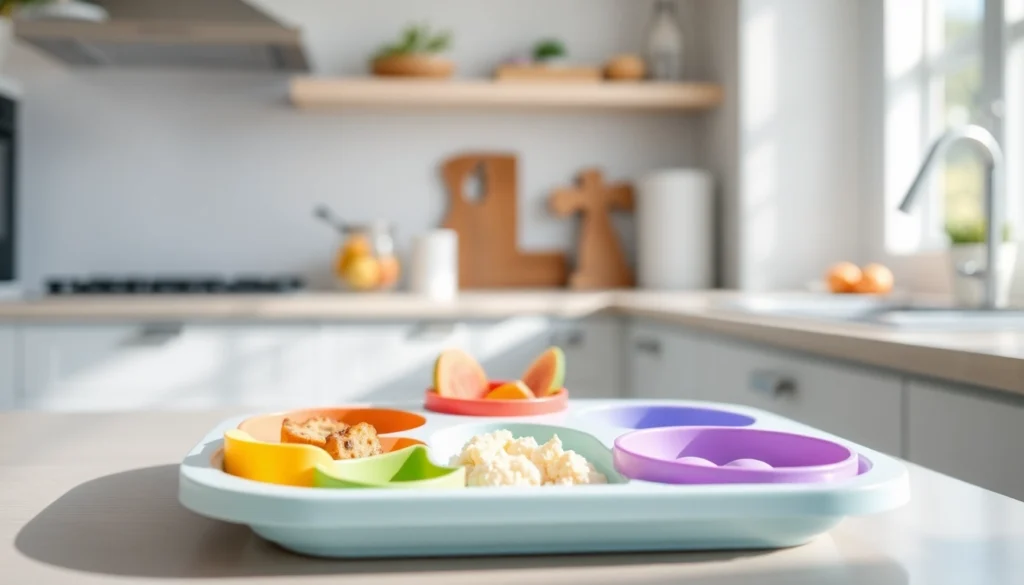
Understanding the Benefits of Silicone Divided Plates for Self Feeding
Introducing your child to mealtime independence is a crucial milestone in their development. One effective tool that facilitates this transition is the silicone divided plate for self feeding. These innovative plates are specially designed to support early autonomy while ensuring safety, engagement, and nutritional balance. In this comprehensive guide, we will explore why silicone is the preferred material for baby tableware, the advantages of divided plates in fostering self-feeding skills, and essential considerations for selecting the optimal plate for your little one.
Why Silicone Is the Material of Choice for Baby Tableware
Silicone has rapidly gained popularity among parents and pediatricians alike due to its unique combination of safety, durability, and flexibility. Unlike traditional plastic options, silicone is a hypoallergenic, non-toxic material that resists bacteria and stains, making it ideal for foods and utensils used by infants. Certified food-grade silicone ensures that no harmful chemicals such as BPA, phthalates, or lead leach into your child’s food, aligning with strict safety standards and regulations. Additionally, silicone’s heat resistance allows it to withstand sterilization and temperature variations, ensuring hygienic use over time. Its soft, pliable texture reduces the risk of injury and minimizes breakage, providing peace of mind to parents who seek reliable and safe feeding solutions.
Advantages of Divided Plates in Early Self Feeding
Divided plates serve several critical functions that significantly enhance the self-feeding process. Their compartmentalized design allows caregivers to portion different food groups in one dish, promoting balanced nutrition. This setup encourages children to explore diverse flavors, textures, and colors, fostering sensory development and meal enjoyment. Moreover, divided plates help children develop cognitive skills related to sorting and categorization, which are foundational for later learning. From a practical perspective, these plates minimize mess by keeping foods separated, thus reducing plate swapping or spillage. Parents observe that children tend to be more engaged at the table when presented with a colorful, organized plate, reinforcing positive mealtime behaviors and independence. When combined with tactile materials like silicone, these plates become powerful tools in nurturing self-sufficiency amidst a safe environment.
How Silicone Plates Promote Safety and Ease of Use
Safety is paramount when choosing tableware for infants, and silicone plates excel in this domain. Their flexible, non-breakable construction prevents sharp edges, reducing potential injuries. Silicone’s inherent heat resistance also allows for hot foods to be served directly onto the plate without warping or melting, maintaining the integrity and safety of the meal. The non-slip base, often featuring a ventosa (suction cup), ensures stability during independent eating attempts, preventing accidental tipping or sliding. This feature boosts confidence in children learning to feed themselves, as they can focus on their coordination skills without the frustration of unstable dishes. Additionally, silicone’s easy-to-clean property simplifies hygiene routines—most plates can be washed in the dishwasher, sterilized, or hand-washed with minimal effort—making daily mealtime routines less stressful for busy parents.
Key Features to Consider When Selecting a Silicone Divided Plate
Design and Compartments: Ensuring Practicality and Engagement
When choosing a silicone divided plate, prioritize thoughtful design that encourages self-feeding and engagement. Multi-compartment options should be deep enough to hold various food textures without spillage, with ergonomic edges that facilitate easy scooping. Plates shaped with fun elements such as rainbow motifs or animal shapes can stimulate interest and make mealtime more enjoyable. Some models feature removable or adjustable compartments, allowing customization based on your child’s evolving needs and preferences. Ergonomic layouts that promote ease of handling—such as slightly raised rims or textured grips—also help children grasp and manipulate the plate confidently, fostering independence early on.
Safety Certifications and Material Quality Standards
Always verify that the silicone plate bears certifications confirming compliance with safety standards such as LFGB (Germany), FDA (USA), or EC regulations (Europe). These certifications guarantee that the material has been tested for potential toxins and is safe for contact with food. Look for labels indicating BPA-free, phthalate-free, and free from other harmful substances. Selecting high-quality, certified silicone not only ensures safety but also durability—plates should withstand frequent use, microwave heating, and sterilization without degrading or losing their properties.
Size, Shape, and Ease of Cleaning for Busy Parents
Choose a plate that fits comfortably within standard dishwashers and is manageable to handle and store. Compact, lightweight designs facilitate transportation for outings or daycare. Rounded edges and smooth surfaces simplify cleaning, preventing food residue buildup. Opt for plates with minimal crevices or complicated textures that can harbor bacteria. An oval or rounded square shape often balances space efficiency and ease of use, while vibrant colors can appeal visually to children, encouraging their participation in mealtime routines.
Best Practices for Introducing a Silicone Divided Plate in Your Child’s Mealtime Routine
Tips for Encouraging Independent Eating with Divided Plates
To foster independence, start by allowing your child to explore the plate with their hands, encouraging tactile engagement. Use positive reinforcement when they attempt to use utensils or self-feed—praise and patience are key. Demonstrate how to scoop and guide their hands initially, gradually giving them more autonomy as they become comfortable. Incorporate colorful, appealing foods in each compartment to stimulate visual interest and curiosity. Consistently maintain mealtimes in a calm, inviting environment, enabling your child to associate positive feelings with self-feeding practices.
Integrating the Plate into Different Feeding Stages
Begin with soft, easy-to-mash foods in early stages of self-feeding, gradually introducing more textured and challenging items as your child’s motor skills develop. The segmented design of silicone plates accommodates this progression seamlessly. For example, start with purees in one compartment and small finger foods in another. As coordination improves, progress to more complex meals requiring scooping, stabbing, or pinching. Transitioning to a silicone divided plate helps maintain consistency and familiarity, easing the transition through different stages of eating.
Maintaining Hygiene and Durability Over Time
Regular cleaning and proper maintenance extend the lifespan of silicone plates. Rinse immediately after use to prevent food from drying and sticking. Most silicone plates can be safely washed in the dishwasher—preferably on the top rack for prolonged durability. For sterilization, boiling or using a microwave sterilizer is effective. Store plates in a dry, clean place away from direct sunlight to prevent material degradation. Inspect plates periodically for signs of wear or discoloration, replacing if necessary, to ensure ongoing safety and hygiene for your child.
Real-Life Examples and Testimonials of Successful Self Feeding
Parent Stories: Transitioning to Self Feeding with Silicone Plates
Many parents have shared inspiring stories of how silicone divided plates boosted their child’s confidence at mealtime. For instance, Emily, a mother of a 10-month-old, reported that introducing a colorful rainbow silicone plate transformed her daughter’s attitude towards eating, helping her develop self-control and coordination. Consistency and patience, combined with the engaging design of the plate, made the transition smooth and enjoyable for both mother and child.
Child Development Milestones Supported by Divided Plates
Using segmented silicone plates aligns with several developmental milestones. Children improve their fine motor skills by grasping utensils and scooping food. Sensory exploration is stimulated by varied textures and visual cues, fostering cognitive associations. Additionally, the act of self-feeding encourages linguistic development, as children gain confidence to communicate their preferences and needs during mealtime.
Common Challenges and Solutions in Using Silicone Self Feeding Plates
Challenges such as plate tipping or reluctance to try new textures can occur. To minimize tipping, ensure plates have reliable suction bases and teach children how to stabilize their hand while eating. If a child is hesitant about certain foods, introduce them gradually and creatively—using dips or combining familiar flavors with new ones. Patience and positive reinforcement are crucial for overcoming initial resistance and fostering long-term acceptance.
Innovations and Future Trends in Baby Self Feeding Accessories
Emerging Materials and Design Features
The future of baby feeding accessories is leaning towards sustainable, eco-friendly materials that maintain safety and durability. Biodegradable silicone blends and innovative surface coatings that resist staining and odors are emerging trends. Additionally, smart features such as sensors that monitor temperature or feeding patterns could soon become part of high-tech infant tableware, offering parents valuable insights.
Technological Enhancements for Better Mealtime Experiences
Advancements include modular plates with adjustable compartments, integrating stacking and nesting capabilities for easy storage, and designing utensils with ergonomic and sensory-responsive features. Some brands are exploring interactive plates with embedded cameras or Bluetooth connectivity to motivate children through gamification, making self-feeding a fun and engaging activity.
How Bebe Boom Continues to Lead in Infant Feeding Accessories
Bebe Boom stays at the forefront by combining Italian craftsmanship, safety certifications, and innovative design. Their range of silicone plates includes features like ventosa bases for stability, vibrant colors to stimulate visual development, and intuitive shapes that enhance motor skills. Their commitment to safety, quality, and continuous innovation ensures that parents trust Bebe Boom as a leader in nurturing their child’s growth through better mealtime accessories.





